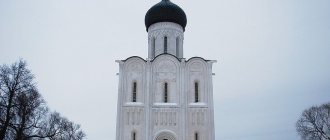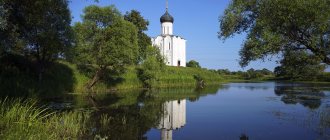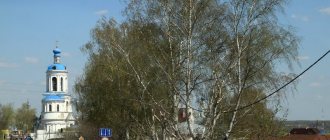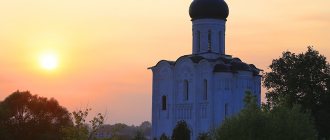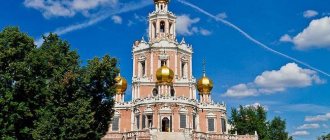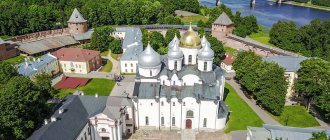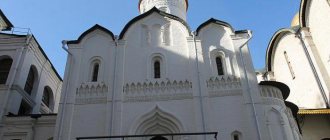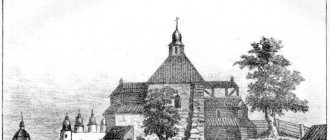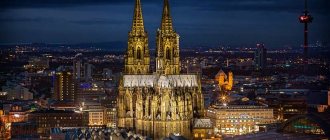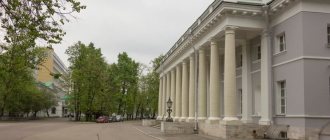The Church of the Intercession on the Nerl (Pokrov on the Nerl) is a white stone church in the Vladimir region of Russia, one and a half kilometers from Bogolyubov, an outstanding monument of architecture of the Vladimir-Suzdal school.
The traditional dating of the temple according to N.N. Voronin is 1165, based on the message from the Life of Andrei Bogolyubsky that the Church of the Intercession was built in memory of the deceased son of the Grand Duke Izyaslav Andreevich. Modern researchers S.V. Zagraevsky and T.P. Timofeeva, based on chronicle information, substantiate the earlier date of the temple - 1158.
According to the Laurentian Chronicle, construction under Prince Andrei was carried out “by masters from all lands.” Tatishchev clarifies in “Russian History” that “the masters were sent from Emperor Frederick the First, with whom Andrei was on friendly terms...” (meaning Frederick Barbarossa).
The church was consecrated in honor of the Feast of the Intercession of the Virgin Mary, established in Rus' in the middle of the 12th century on the initiative of Andrei Bogolyubsky. This is probably the first Church of the Intercession in Rus' [source not specified 1093 days].
According to the legend contained in the Life of Andrei Bogolyubsky, the white stone for the construction of the church was taken from the Bulgarian kingdom conquered by Andrei Bogolyubsky. However, this legend is refuted both by historical facts and by the results of paleographic analyzes of the white stone used to build the church.
In 1784, due to the low profitability of the Church of the Intercession, the abbot of the Bogolyubov Monastery (to which it was assigned) tried to dismantle the temple for building material for the construction of the monastery bell tower, but lack of funds did not allow work to begin.
Background to the emergence of the church
The Church of the Intercession on the Nerl has its own history, which is quite vague, since it was a long time ago. According to some reports, the idea of building a church came to Andrei Bogolyubsky after the Bulgars were defeated. By the way, the Feast of the Intercession at that time was quite young in Rus', and the victory was attributed to the patronage of the Mother of God. Since then, when warriors went to battle, they asked the Mother of God for intercession.
This temple, according to some sources, is the first of those dedicated to the Feast of the Intercession. This is also the memory of the son of Prince Andrei Izyaslav, who died from wounds in the battle against the Bulgars.
UNESCO heritage
The Church of the Intercession on the Nerl is an architectural masterpiece recognized throughout the world. Since 1992, as part of the “White Stone Monuments of Vladimir and Suzdal”, the temple has been included in the UNESCO World Heritage List. Among the eight majestic monuments of ancient architecture of the Vladimir-Suzdal school, this is the most poetic. A white church, surrounded by green meadows, directed with a strict dome towards the blue sky... A poem imprinted in stone.
Church of the Intercession on the Nerl
(
Pokrov on the Nerl
) is a white-stone temple in the Vladimir region of Russia, one and a half kilometers from , an outstanding monument of architecture of the Vladimir-Suzdal school.
The traditional dating of the temple according to N.N. Voronin is 1165, based on the message from the Life of Andrei Bogolyubsky that the Church of the Intercession was built in memory of the deceased son of the Grand Duke Izyaslav Andreevich. Modern researchers S.V. Zagraevsky and T.P. Timofeeva, based on chronicle information, substantiate the earlier date of the temple - 1158.
According to the Laurentian Chronicle, construction under Prince Andrei was carried out “by masters from all lands.” Tatishchev clarifies in “Russian History” that “the masters were sent from Emperor Frederick the First, with whom Andrei was on friendly terms...” (meaning Frederick Barbarossa).
The church was consecrated in honor of the Feast of the Intercession of the Virgin Mary, established in Rus' in the middle of the 12th century on the initiative of Andrei Bogolyubsky. This is probably the first Church of the Intercession in Russia [ source not specified 1093 days
] .
According to the legend contained in the Life of Andrei Bogolyubsky, the white stone for the construction of the church was taken from the Bulgarian kingdom conquered by Andrei Bogolyubsky. However, this legend is refuted both by historical facts and by the results of paleographic analyzes of the white stone used to build the church.
In 1784, due to the low profitability of the Church of the Intercession, the abbot of the Bogolyubov Monastery (to which it was assigned) tried to dismantle the temple for building material for the construction of the monastery bell tower, but lack of funds did not allow work to begin.
Beginning of construction of the temple
The Church of the Intercession on the Nerl was built in 1165. However, some historians disagree on the date. According to some sources, construction took place in 1165-1667, while other sources claim that this happened in 1158.
The first date is taken from the biography of Andrei Bogolyubsky himself, and the second - from the Vladimir chronicler, which was written in the 16th century. One way or another, construction has begun. Some historians claim that the white stone from which the temple was built was brought here by the defeated Bulgars themselves.
The location of the church is such that Prince Andrei could see it from the windows of his mansion, and construction began with the construction of the foundation, since in the spring the river here overflowed its banks. On the outside, the whole thing was lined with slabs of white stone.
Description
The Church of the Intercession on the Nerl was built in 1165. Historical sources connect its construction with the victorious campaign of the Vladimir regiments against Volga Bulgaria in 1164. It was on this campaign that the young Prince Izyaslav died. In memory of these events, Andrei Bogolyubsky founded the Intercession Church. According to some news, the white stone for the construction of the church was delivered as an indemnity by the defeated Volga Bulgars themselves. According to another legend, Prince Andrei Bogolyubsky built this temple in sublime sadness in memory of his eldest son Izyaslav, who died in a campaign against Volga Bulgaria. Structurally, the Church of the Intercession on the Nerl is very simple - it is a single-domed, cross-domed, four-pillar temple, typical for ancient Russian architecture. The church is small and surprisingly harmonious. The semi-cylinders of the apse, so heavy and protruding so strongly in the buildings of Yuri Dolgoruky, here seem to be recessed into the body of the temple, and the eastern (altar) part does not outweigh the western. Complexly profiled pilasters with light semi-columns emphasize the upward movement of the composition of the elegant temple. An arcature-columnar belt, the thin columns of which rest on carved brackets, runs along all the facades and under the apse cornice. Above the arcature-columnar belt, the walls are decorated with reliefs. The vertical aspiration gradually and imperceptibly turns into the semicircular outlines of mosquitoes. The semicircles of the zakomar are echoed by the completion of gracefully elongated windows. And finally, the church is crowned with a semicircular dome, which used to be helmet-shaped, but now resembles an onion. In 1954 - 1955 During archaeological research, foundations of unknown purpose were discovered. Most likely, this is the base of an unpreserved arched gallery that went around the church on three sides at a distance of two and a half meters from the walls. The interior decoration - the frescoes have not survived; they were knocked down during the “renovation” of the temple in 1877. The location for the church - a floodplain meadow at the confluence of the Nerl and the Klyazma - was indicated by Prince Andrei Bogolyubsky himself. Since there was widespread flooding here every spring, a high foundation was built especially for the temple - an artificial hill made of clay and cobblestone, in which the foundations of the future building were laid. The outside of this hill was lined with white stone slabs. When the Nerl floods in the spring, the church remains on a small island, reflected in the fast-flowing waters that approach right up to its walls. The Church of the Intercession on the Nerl is compared to ancient Greek temples in its brevity and perfection of forms. Looking at this amazing creation of Russian masters, it is difficult to believe that the Church of the Intercession on the Nerl was only miraculously saved from destruction. And he was in danger not from the militant atheists of the communist era, but from the Orthodox clergy. In 1784, the abbot of the Bogolyubov Monastery petitioned the diocesan authorities for permission to dismantle the Church of the Intercession on the Nerl in order to use its material to build the monastery bell tower. The Bishop of Vladimir gave such permission. The church survived only because customers and contractors did not agree on the price. In all of Russian architecture, which has created so many unsurpassed masterpieces, there is probably no more lyrical monument. This amazingly harmonious white stone temple, organically merging with the surrounding landscape, is called a poem captured in stone. The temple is included in the UNESCO World Heritage List.
Address: Vladimir region, Bogolyubovo village
Alisa Gorodtsova
One and a half kilometers to the nearest fortified town of Bogolyubov. Pilgrims walk on foot through water meadows and off-road to see the walls that still remember the Tatar-Mongol yoke. According to legend, the Church of the Intercession of the Virgin Mary was built in honor of the victory of Prince Andrei Bogolyubsky over the Bulgars in the mid-12th century. The life of the prince also reports that this temple is a tribute to the memory of Izyaslav Andreevich, the son of the Grand Duke. Izyaslav died from wounds received during a military campaign.
The prince chose the place for the temple in the flooded meadows, at the crossroads of two rivers - the Nerl and Klyazma. Before construction, it was necessary to build a hill of stones held together with clay as protection from spring waters. History has not preserved the names of the architects, but the craftsmen were skilled: they began to build the walls at a depth of five meters and decorated the temple with stone slabs. So even in the deepest flood, the basements do not flood. This allowed the church to stand for eight centuries.
“The ideal consistency of the general and the particular, the whole and the smallest details creates a subtle and enlightened harmony, likening architecture to spiritual and soaring music or song”
, writes one of the leading experts on ancient Russian architecture, Nikolai Voronin.
“The image of the famous creation of the Vladimir masters is so perfect that there was never any doubt that this was how it was originally, that this is how it was conceived by its architects
.
The Church on the Nerl is the first in Russia consecrated in honor of the Feast of the Intercession of the Blessed Virgin Mary. Shortly before the construction of the church, the priests and the prince himself adopted this spiritual holiday as a sign of the special mercy of the Blessed Virgin to the land of Vladimir. The main temple of Vladimir is also dedicated to the Mother of God - unlike Kyiv, Novgorod, Pskov, Polotsk and other princely capitals.
The frescoes that decorated the walls of the Church of the Intercession on the Nerl depicted King David on the throne. At his feet are lions and griffins, and doves soar around. Three female faces on the frescoes, as in all Vladimir churches, symbolize the Mother of God.
In the 18th century, the church barely withstood the onslaught of time. The roof almost crumbled, the dome almost collapsed, and the carved bas-reliefs were also damaged. By 1784, the temple had fallen into such a deplorable state that the abbot of the Bogolyubov Monastery asked the diocese for permission to dismantle the church and use the stone for a new bell tower. The white stone miracle survived for worldly reasons: the workers demanded such a high price that they decided to leave the temple and even restored it.
In the mid-twentieth century, archaeological excavations were carried out around the church. Scientists have discovered the remains of an ancient foundation. It is believed that this is part of a gallery that once surrounded the temple on three sides. Fragments of figures of animals and birds carved from white stone also survived.
Church architecture
In combination with the surrounding beauties, the temple seems to be an island of purity and grace of Russian architecture. Perhaps it was precisely for this beauty that S. V. Gerasimov painted “The Church of the Intercession on the Nerl”. Although if you look carefully, there is nothing special or pretentious in the temple. The building itself is simple, like many buildings of this type were at that time. It is a cross-domed temple on four pillars.
However, this is where the similarities with other similar structures end. The Church of the Intercession is very elegant, light and bright. All this cannot be found anywhere else. The architects tried to convey the aspiration upward, towards God. This was done by using some tricks in the construction (for example, many vertical lines, a barely noticeable inclination of the walls inward).
Initially, the temple was decorated with a helmet-shaped dome, but during reconstruction in 1803 it was replaced with an onion dome, which still stands today. The walls of the church are decorated with white stone carvings, which were traditional at that time.
The temple has three facades, each of which is decorated with an image of King David seated on a throne. On both sides there are a dove, and below are lions. Below the animals are masks of women whose hair is braided. These masks are a symbol of the Mother of God. They were very often depicted on temples of that era.
Architecture
Church of the Intercession of the Virgin on the Nerl
After construction and finishing work was completed, the church looked great. Architecturally, it was an ordinary single-domed church with a cross, standing on a quadrangle. And at the same time, the Church of the Intercession of the Virgin Mary on the Nerl is something completely new and special! Its walls are built with a slight slope into the temple, making it visually appear higher than it actually is. Plus, the variety of vertical lines lengthen its silhouette.
Interior decoration of the temple
Those who visit the Church of the Intercession on the Nerl are not allowed to take photos. However, from the descriptions of those who visited there, it can be noted that the internal structure of the temple supports the same idea, namely, aspiration upward. The vaulted pillars, slightly tapering towards the top, visually increase the height of the temple. The dome seems to simply float in the sky, especially when illuminated by light. Initially, it was decorated with the image of Christ Pantocrator surrounded by archangels and seraphim. The walls were decorated with colorful frescoes and the floor was covered with colored majolica tiles.
All this decoration, of course, became dilapidated over the centuries, but it was completely destroyed in 1877, when they decided to restore the temple. I would like to note that, despite the destruction, the church retained the main thing that the builders and architects tried to give it. It was a striving upward, which is still visible today, the superiority of spiritual values over material ones. Obviously, this is what allowed the temple not to fade away among many similar ones, but, on the contrary, to rise. In 1992, it was inscribed on the UNESCO World Heritage List.
State of the Church Today
The temple on the Nerl is now shared by the Russian Orthodox Church and the Vladimir-Suzdal Museum-Reserve. In relation to the latter, the building is part of the Mother of God Nativity Monastery.
Unfortunately, the original interior paintings of the temple were completely lost (they were knocked down during renovation in 1877)
Externally, the church is well preserved. The walls are regularly plastered and tinted by the monks and museum staff. The interior decoration is decorated with several icons and candlesticks. The walls are left empty.
Please note: The chapel is open daily, but services are only held on Sundays and Christian holidays. There are 3 monks living at the monastery courtyard who conduct all religious rituals.
Naming the church
According to some sources, initially the temple should have been dedicated not to the Intercession, but to the Mother of God. This is due to the miracle that happened to the prince during the campaign against the Bulgars (the patronage of the Most Holy Theotokos, which subsequently led to the appearance of this church holiday).
However, there is another version of what the Church of the Intercession on the Nerl could be dedicated to. The church had peculiar figures in the drum paintings, which pointed to another holiday, namely, the Destruction of the Wood of the Cross of the Lord. This version is confirmed by the fact that a cross was discovered in the vicinity of the temple, which dates back to the 12th century. Close proximity to water further indicates this.
Thus, initially the church could combine dedication to several important dates, but nevertheless it became Pokrovskaya.
A miracle that happened before the construction of the temple
Now we should talk about the miracle that forced Prince Andrei to somewhat change the name of the temple and begin construction altogether. This happened during a campaign, when the prince ordered an icon of the Mother of God with a baby in her arms to be carried along with him. All the way they were haunted by miracles, which were regarded as the intercession of the Mother of God.
The first miracle happened at the place where Andrei Bogolyubsky built his castle. Here the horses were unable to continue their journey further to Rostov, as planned. They simply could not move the cart where the icon was. Then she predetermined the campaign against the Bulgars in favor of the Russians. Strong rays began to emanate from the icon, protecting the army of Andrei Bogolyubsky.
So the Church of the Intercession on the Nerl was renamed. The church was the first to be dedicated to this holiday.
Story
The Church in the name of the Intercession of the Blessed Virgin Mary appeared at the mouth of the Nerl River in the middle of the 12th century, during the reign of Andrei Bogolyubsky in the Vladimir-Suzdal principality. Over 8 centuries, the building has witnessed many historical events that hid information about its history. Only in the middle of the last century did the ancient church begin to reveal its secrets.
Church of the Intercession on the Nerl, Vladimir region
Construction time
The chronicles indicate that the church in the name of the Virgin Mary was built in one year. However, researchers have not been able to determine the exact date of these events for a long time. Two possible dates are given:
- The date 1165 is based on the research of historian Nikolai Voronin. According to the chronicles, the Grand Duke built a church in honor of the victorious campaign against the Volga Bulgars, as well as in memory of his son Izyaslav Andreevich who died in it. From this point of view, the building is a temple-monument resembling a funeral candle.
- A local historian from Vladimir, based on the chronicler’s report about the simultaneous construction of two Virgin Mary churches on the territory of Bogolyubov, postpones the construction date of the Intercession Church to 1158.
The rapid construction of the snow-white building is explained by the crowded team that worked on its creation and the small size of the facility.
Construction site
The temple was built near the new residence of Andrei Bogolyubsky on a water meadow at the confluence of the Nerl River and Klyazma. During river floods, the building is surrounded by water. This circumstance raises many questions. There are two versions about the meaning of choosing this place for construction.
Interior of the Church of the Intercession on the Nerl
- The Church of the Intercession served as a ceremonial princely temple, which met people following the trade river route to the Volga.
- The building was part of a monastery, which had fortified walls. He defended Bogolyubov and Vladimir from attacks from the Volga Bulgaria. It is known that the monastery existed on this site until the middle of the 18th century. It should be noted that the remains of the fortifications were not preserved and were not discovered during excavations.
Construction
The sources do not contain information about the craftsmen who participated in the construction of the unique building. Perhaps this work was carried out by local craftsmen and members of the European artel who participated in the construction of Bogolyubov.
The process of building a simple-looking temple was complicated by the difficult location chosen for construction. The builders created a unique foundation design that allowed the building to rise above the water during floods.
Initially, a strip foundation 1.6 m deep was dug on the river spit, which was filled with cobblestones and filled with mortar. Stone walls, the height of which is 3.5 m, were installed on this base. They were filled with local loamy soils and lined with white limestone slabs. A white stone church was installed on the resulting artificial elevation.
Description of architecture and interior decoration
Like most Russian churches of the pre-Mongol period, the Church of the Intercession on the Nerl is a building in the Romanesque style, belonging to the cross-domed type. The central part was a square covered with arched vaults, which rested on the outer walls and four inner pillars.
On the eastern side there was a three-part apse. The remaining facades were surrounded by a wide open walkway. A helmet-shaped head was installed on a high narrow drum. The facades of the building were decorated with many bas-reliefs.
They depicted the biblical King David, sitting surrounded by lions, mythical beasts of prey and doves. In the wide strands of each facade there is a belt of women's faces, symbolizing Sophia (wisdom).
Painting the walls of the Intercession Church
The interior walls and vaults of the temple were originally decorated with paintings and frescoes. The craftsmen laid out floral patterns from majolica on the floors. A wide stone staircase rose from the river bank to the western façade. According to archaeological excavations, there were figures of lions on the stairs.
Naming the church
The temple on the banks of the Nerl is the first religious building named in honor of the Feast of the Intercession of the Blessed Virgin Mary. It is believed that this holiday was introduced into use by Andrei Bogolyubsky, who reverently revered the Heavenly Intercessor. According to legend, during the campaign against the Bulgars, in whose memory the church was built, the prince took the image of the Savior Not Made by Hands, the icon of the Vladimir Mother of God and the cross.
During the battle, a fiery cloud emanated from the shrines, which frightened the enemy and decided the outcome of the battle in favor of the Russian troops. This event reminded the prince of the events of 200 years ago, when the Mother of God, during the siege of Constantinople by the Ottomans, prayed with the townspeople in the Blacher Church, and then covered them with her veil. In honor of this event, the Feast of the Intercession was established.
Interesting: the ancient cross that accompanied the prince in battle stood near the Church of the Intercession for several centuries. Only at the beginning of the 20th century. it was transferred to the Bogolyubov Historical Museum.
XIII - XX centuries
The appearance of the temple was damaged during internecine clashes between Russian princes and Tatar raids. The first mentions of the Intercession Monastery appeared in documents of the 16th century. Its cathedral church was first renovated at the beginning of the next century. It is believed that the cemetery was dismantled at this time.
In the 18th century, the Intercession Monastery rose to prominence for a short time, but already during the reign of Catherine the Great it became one of the abolished monasteries. The Church of the Intercession on the Nerl was assigned to the Vladimir Nativity Monastery. At the end of the 19th century, the building underwent restoration, during which the interior paintings and frescoes disappeared forever, the floor majolica was destroyed, and an onion dome was installed.
White stone carving of the Intercession Church
During Soviet times, the authorities recognized the temple as an important architectural monument. He was taken under state protection. In 1991, the temple was transferred to the joint ownership of the Russian Orthodox Church and the Vladimir-Suzdal Architectural Reserve.
An important event for all white stone buildings was their inclusion in 1992 on the UNESCO World Architectural Heritage List.
Archaeological excavations
It should be noted that some of the temple structures have not survived to this day. Excavations have shown that the structure was once surrounded on three sides by an open gallery made of white stone. It was paved with majolica tiles (very bright). There was also a staircase that was located in the southwest corner of the gallery. She went up to the choir. The gallery was supported by pillars made of white stone; figures of various animals were installed on the parapet (among them was a leopard in a jump - this is a symbol of the Vladimir dynasty). All that remains of the gallery are the foundations, which are located at a distance of two and a half meters from the walls of the temple.
Appearance. Mysterious ornaments of white stone carvings
King David Women's Masks Lions Pigeons facade ornament
On the facades of the church there are stone carvings characteristic of those times. The patterns fit easily into the slender frame of the temple. The bas-reliefs depict King David singing psalms; lions located under him; and on either side of him are pigeons. An arcature belt surrounds the silhouette of the temple. Below them are women's faces with long hair in braids. The faces seem to illuminate everything around, decorating the facades of the church on three sides.
Arcature belt
Judging by its appearance and archaeological research, it is clear that the church was previously surrounded by a gallery on three sides. A staircase rose from it into the choir, located in the southwest of the gallery. In the historical archives of the Vladimir lands, a description of the patterns that decorated it has been preserved. So griffins and other, the most diverse and outlandish mythical creatures were carved into white stone. And the main ornamental elements of the carving were jumping leopards - a symbol of the princely dynasty in the Vladimir lands.
Bogolyubsky Monastery
A few words should be said about the Bogolyubsky Monastery, which was also built by Prince Andrei at approximately the same time as the temple. In addition, although the church was remote from it, it belonged to the monastery.
This is a women's monastery, which is located in the village of Bogolyubovo. Initially, it was a princely residence, on the territory of which a temple dedicated to the Nativity of the Virgin Mary was built. Andrei Bogolyubsky also ordered the construction of a stone palace on two floors.
After the prince was killed here, according to historians, it was decided to found a monastery here. He experienced a large number of shocks (looting, devastation, destruction). However, today this is one of the oldest buildings; besides this monastery, no other buildings from those times have survived.
During Soviet times, the monastery became a museum. This continued until 1991, when the monastery opened, and sixty sisters from the Zadonsk Monastery settled here. In 1997, monks appeared in the monastery. This led to a more active revival of the monastery.
Pilgrimage to the Church
According to numerous visitors to the church, it has an unspoken charm. Obviously, this is why the Church of the Intercession on the Nerl (photos confirm this) is so popular for pilgrims even now. The temple is active, services are regularly held there, the rest of the time it is a museum. You cannot take photographs in it, so if you want to capture the internal structure of the temple, then most likely this will not work.
Arriving at the church, you can listen to the history of the construction of the temple, the history of Prince Bogolyubsky. They also sell photos and books that you can purchase to keep images and descriptions of the temple as a souvenir. The Church of the Intercession on the Nerl makes an indelible impression on everyone.
By the way, the visit to the temple itself goes quite quickly, so on the way back you can visit the Bogolyubsky Monastery, and you can also go to Suzdal and Vladimir. This will be quite an exciting journey from which you will bring back a lot of impressions. Also in Bogolyubovo you can buy souvenirs to suit your taste, which are made by local craftsmen.
Current situation
The meadow on which the church is located is now a specially protected natural area and declared a historical and landscape complex of regional significance. The Church of the Intercession on the Nerl itself has been included in the UNESCO World Heritage Site since 1992 under the name “White Stone Monuments of Vladimir and Suzdal”.
Currently, the temple is jointly managed by the Russian Orthodox Church and the Vladimir-Suzdal Museum-Reserve. Regular services are held in the temple; the rest of the time it is open as a museum exhibition. Excursion services are provided.
The temple in the Vladimir region, located one and a half kilometers from the village of Bogolyubovo, is an outstanding monument of Russian architecture of the Vladimir-Suzdal school. It could have disappeared from the face of the earth, but has survived to this day and is considered one of the most magnificent churches in Russia. Experts call it the greatest masterpiece of world art, the “white swan” of Russian architecture. In terms of the perfection of its forms, this church is compared with the most famous ancient temples.
Location and address of the church
If you decide to visit the Church of the Intercession on the Nerl, you should know that getting to it is not difficult, but a little inconvenient. The temple is located on the territory of the reserve, which is called “Bogolyubovsky Meadow - Church of the Intercession”. If you are traveling from the city of Vladimir by car, then you should take the highway to Nizhny Novgorod. Along the way you will see a large village - this is Bogolyubovo. In its center you can see another majestic structure - the Holy Bogolyubsky Monastery, which is also interesting to visit.
You can also get to the village by bus or commuter train. Then you should walk about one and a half kilometers. However, you can pay for the ride on a horse-drawn carriage.
Description and architectural features
The location of the Church of the Intercession on the Nerl is unique for ancient Russian churches. It stands in a lowland, on a hill only 6 meters high, although most religious buildings in the Middle Ages were built on hills.
The walls of the church are strictly vertical, but thanks to the exceptionally well-found proportions, they look inclined inward, which achieves the illusion of a greater height of the structure
This is interesting: the foundation of the chapel is made of untreated stones filled with lime. Its total depth exceeds 5 meters. Such a powerful foundation was made so that the structure could stand even during spring floods, when the level of the Klyazma and Nerl rivers rises by more than 3 meters.
The continuation is the walls, decorated with bas-reliefs, with images of King David the psalmist, lions and griffins. The walls are also decorated with pilasters with half-columns. Inside the temple they correspond to small projections.
Architectural plan of the Church of the Intercession
In plan, the structure is a square with a side of 10 meters. The space under the dome of the temple is also a square with sides 3.2 meters long. Architecturally, the church belongs to Byzantine type buildings. Inside, 4 pillars divide it into 9 cells. The columns and walls taper towards the top and give the impression of the great height of the temple.
It is worth noting: due to its precise proportions and beautiful appearance, the Church of the Intercession on the Nerl is considered by many researchers and ordinary people to be the most beautiful religious building in Russia.
The beauty of nature around the church
The temple was built near the Nerl River, namely in a floodplain meadow where the river flows into the Klyazma. It stands on an artificially constructed hill, since every spring the river overflows its banks here. And now, when this happens, the church finds itself on a small island, and the waters seem to come right up to the walls. This is a very beautiful sight, as many people confirm. The Church of the Intercession on the Nerl was built in such a way that it fits very harmoniously into the surrounding landscape; it seems to naturally grow out of the ground.
Once upon a time, there was a pier near the temple, and river ships that sailed along the Klyazma could moor and stop. Of course, this is not the case now, but even from a distance it is a wonderful ensemble, which is embodied in more than one painting. The Church of the Intercession on the Nerl was captured by several artists. These canvases are considered truly masterpieces in art.
Church of the Intercession on the Nerl in art
The beauty of this temple has repeatedly attracted people of art. She inspired many to create sublime poetic works and poems. Some captured these beauties on canvas. For example, S. V. Gerasimov’s painting “The Church of the Intercession on the Nerl” is rightfully considered one of the masterpieces. He managed to accurately convey the almost unearthly beauty of the temple, surrounded by untouched nature.
Many people have written essays on this topic. The Church of the Intercession on the Nerl was described by many schoolchildren, as well as simply landscape lovers. Be that as it may, since the time of its construction (and more than 800 years have passed), it has not lost its purity, grace and sophistication. Until now, pilgrims come to this area to admire the interesting ancient creation of man’s hands in combination with a truly Russian landscape.
Current state
Currently, the temple is part of the Bogolyubovsky Meadow museum complex, which is part of the architectural reserve. Divine services are also held there. From the time of construction, external bas-reliefs and an arcature belt on the facade have survived to the present day.
The interior of the temple is distinguished by its asceticism, since it was decided not to restore the lost paintings and floor mosaics. The surrounding area is a meadow along which a path paved with slabs leads to the attraction.
